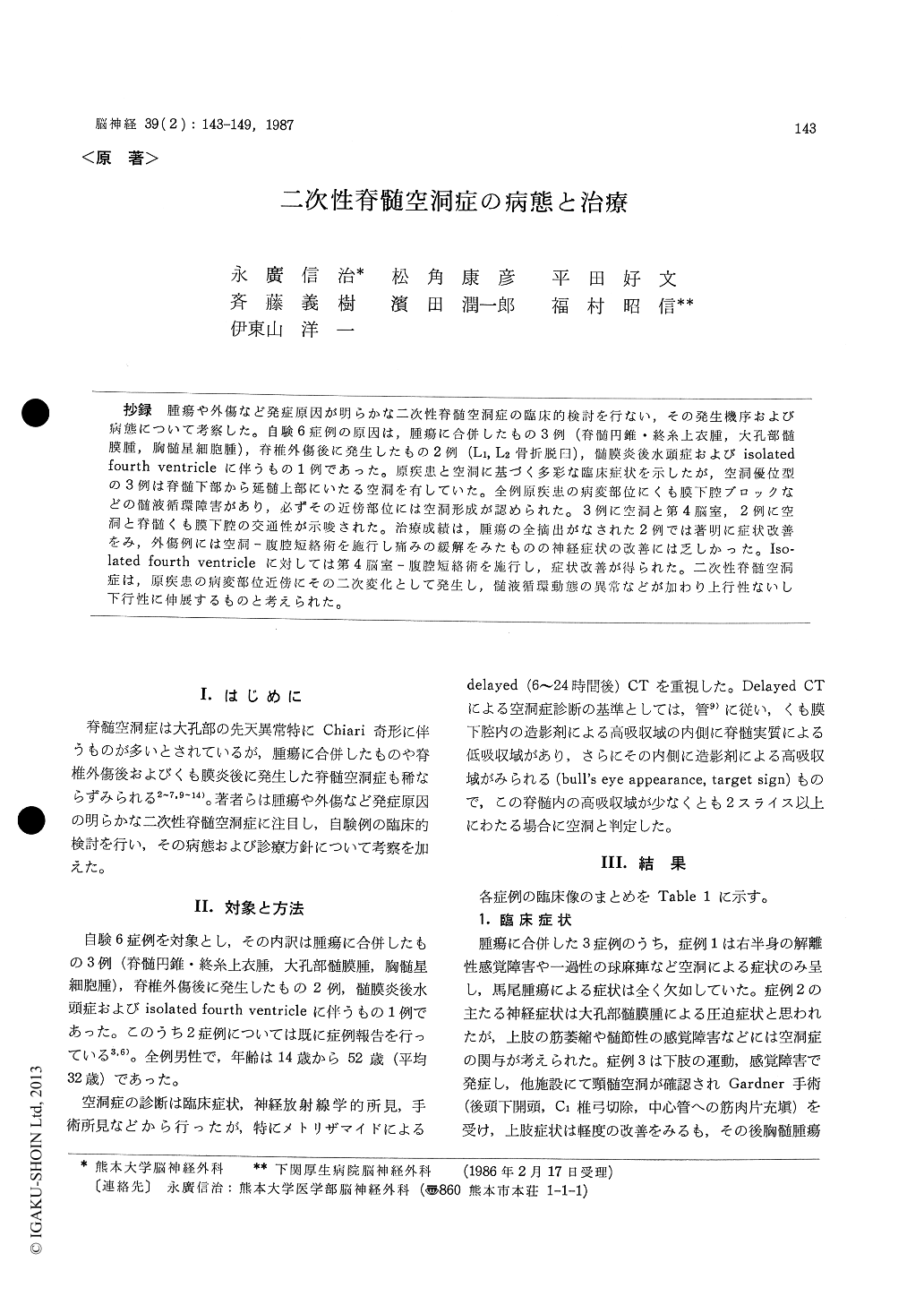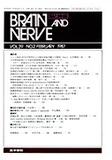Japanese
English
- 有料閲覧
- Abstract 文献概要
- 1ページ目 Look Inside
抄録 腫瘍や外傷など発症原因が明らかな二次性脊髄空洞症の臨床的検討を行ない,その発生機序および病態について考察した。自験6症例の原因は,腫瘍に合併したもの3例(脊髄円錐・終糸上衣腫,大孔部髄膜腫,胸髄星細胞腫),脊椎外傷後に発生したもの2例(L1, L2骨折脱臼),髄膜炎後水頭症およびisolatedfourth ventricleに伴うもの1例であった。原疾患と空洞に基づく多彩な臨床症状を示したが,空洞優位型の3例は脊髄下部から延髄上部にいたる空洞を有していた。全例原疾患の病変部位にくも膜下腔ブロックなどの髄液循環障害があり,必ずその近傍部位には空洞形成が認められた。3例に空洞と第4脳室,2例に空洞と脊髄くも膜下腔の交通性が示唆された。治療成績は,腫瘍の全摘出がなされた2例では著明に症状改善をみ,外傷例には空洞—腹腔短絡術を施行し痛みの緩解をみたものの神経症状の改善には乏しかった。ISo-lated fourth ventricleに対しては第4脳室—腹腔短絡術を施行し,症状改善が得られた。二次性脊髄空洞症は,原疾患の病変部位近傍にその二次変化として発生し,髄液循環動態の異常などが加わり上行性ないし下行性に伸展するものと考えられた。
Six cases with secondary syringomyelia were evaluated clinically and the pathogenesis was discussed.
Three cases had the tumors ; an ependymoma arising from the conus medullaris and the filum terminale, a foramen magnum meningioma extend-ing to C2 and a thoracic astrocytoma. Two cases had past history of spinal cord injury with L1 and L2 fracture-dislocation, respectively. One case showed hydromyelic symptoms associated with isolated fourth ventricle after postmeningitic hyd-rocephalus.
Clinical symptoms and signs were complex and various in each case due to the association of the original disease and the syrinx. Syringomyelic symptoms were dominant in three cases of which the syrinx extended from the conus to the cervical cord. Initial symptoms of two cases with post-trau-matic syringomyelia were tingling pains which be-gan near the site of injury and extended rostrally. Metrizamide myelography revealed complete or incomplete block at the location of the tumors or the injuries. Delayed CT demonstrated the syrinx in all cases. The syrinx was always present near the sites of primary lesions. The communication between the syrinx and the fourth ventricle was suspected in three cases, and the communicationof the syrinx and the spinal subarachnoid space was suspected in two cases.
All cases underwent the surgical treatments. Total removal of the tumors were completed in two cases and relieved the majority of symptoms. On the other hand, a case with a thoracic astrocytoma underwent biopsy of the tumor and irradiation, fol-lowed by poor outcome. Syringo-peritoneal shunts were performed in two cases with post-traumatic syringomyelia and relieved pain, but neurological signs were unchanged. Fourth ventriculo-peritoneal shunt relieved hydromyelic symptoms in a casewith isolated fourth ventricle.
We propose two stages for the pathogenesis of secondary syringomyelia. The first stage is intra-medullary cavity formation at the site of the pri-mary lesion due to edema, circulatory distur-bance or necrosis. The second stage is progres-sive cord cavitation, that may be related to the relative excess CSF inflow into the cavity in comparison with its outflow under the state of abnormal CSF dynamics.

Copyright © 1987, Igaku-Shoin Ltd. All rights reserved.


